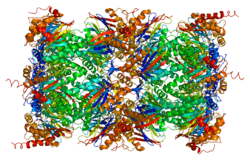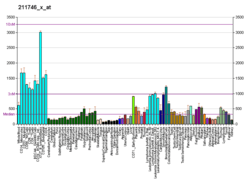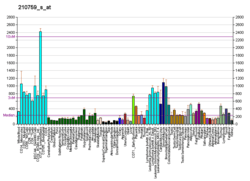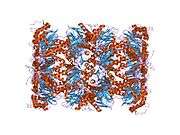Proteasome (prosome, macropain) subunit, alpha 1
Proteasome subunit alpha type-1 is a protein that in humans is encoded by the PSMA1 gene.[5][6][7] This protein is one of the 17 essential subunits (alpha subunits 1–7, constitutive beta subunits 1–7, and inducible subunits including beta1i, beta2i, and beta5i) that contributes to the complete assembly of 20S proteasome complex.
Structure
Protein expression
Th gene PSMA1 encodes a member of the peptidase T1A family, that is a 20S core alpha subunit.[7] In a study of mouse gene PSMA1 which share 98% homology with human gene, the gene was isolated and cloned, and then identified as C2 subunit of the 20S proteasome (old nomenclature). The gene has 10 exons that are distributed over a 12kb region on mouse chromosome 7. The same study showed that mouse genes Psma1 and Pde3b are closely linked, residing between cM 53 and 53.3 in a region syntenic to human chromosome 11p15. The human protein proteasome subunit alpha type-1 is also known as 20S proteasome subunit alpha-6 (based on systematic nomenclature). The protein is 30 kDa in size and composed of 263 amino acids. The calculated theoretical pI of this protein is 6.15.
Complex assembly
The proteasome is a multicatalytic proteinase complex with a highly ordered 20S core structure. This barrel-shaped core structure is composed of 4 axially stacked rings of 28 non-identical subunits: The two end rings are each formed by 7 alpha subunits, and the two central rings are each formed by 7 beta subunits. Three beta subunits (beta1, beta2, and beta5) each contains a proteolytic active site. Proteasomes are distributed throughout eukaryotic cells at a high concentration and cleave peptides in an ATP/ubiquitin-dependent process in a non-lysosomal pathway.[8][9]
Function
Crystal structures of isolated 20S proteasome complex demonstrate that the two rings of beta subunits form a proteolytic chamber and maintain all their active sites of proteolysis within the chamber.[9] Concomitantly, the rings of alpha subunits form the entrance of substrate entering the proteolytic chamber. In an inactivated 20S proteasome complex, the gate into the internal proteolytic chamber are guarded by N-terminal tails of specific alpha-subunit.[10][11] The proteolytic capacity of 20S core particle (CP) can be activated when CP associates with one or two regulatory particles (RP) on one or both side of alpha rings. These regulatory particles include 19S proteasome complexes, 11S proteasome complex, etc. Following the CP-RP association, the confirmation of certain alpha subunits will change and consequently cause the opening of substrate entrance gate. Besides RPs, the 20S proteasomes can also be effectively activated by other mild chemical treatments, such as exposure to low levels of sodium dodecylsulfate (SDS).[11] As a component of alpha ring, Proteasome subunit alpha type-1 contributes to the formation of heptameric alpha rings and substrate entrance gate. The eukaryotic proteasome recognized degradable proteins, including damaged proteins for protein quality control purpose or key regulatory protein components for dynamic biological processes. An essential function of a modified proteasome, the immunoproteasome, is the processing of class I MHC peptides.
Clinical significance
The proteasome and its subunits are of clinical significance for at least two reasons: (1) a compromised complex assembly or a dysfunctional proteasome can be associated with the underlying pathophysiology of specific diseases, and (2) they can be exploited as drug targets for therapeutic interventions. More recently, effort has been made to consider the proteasome for the development of novel diagnostic markers and strategies. An improved and comprehensive understanding of the pathophysiology of the proteasome should lead to clinical applications in the future.
The proteasomes form a pivotal component for the ubiquitin–proteasome system (UPS) [12] and corresponding cellular Protein Quality Control (PQC). Protein ubiquitination and subsequent proteolysis and degradation by the proteasome are important mechanisms in the regulation of the cell cycle, cell growth and differentiation, gene transcription, signal transduction and apoptosis.[13] Subsequently, a compromised proteasome complex assembly and function lead to reduced proteolytic activities and the accumulation of damaged or misfolded protein species. Such protein accumulation may contribute to the pathogenesis and phenotypic characteristics in neurodegenerative diseases,[14][15] cardiovascular diseases,[16][17][18] inflammatory responses and autoimmune diseases,[19] and systemic DNA damage responses leading to malignancies.[20]
Several experimental and clinical studies have indicated that aberrations and deregulations of the UPS contribute to the pathogenesis of several neurodegenerative and myodegenerative disorders, including Alzheimer's disease,[21] Parkinson's disease[22] and Pick's disease,[23] Amyotrophic lateral sclerosis (ALS),[23] Huntington's disease,[22] Creutzfeldt–Jakob disease,[24] and motor neuron diseases, polyglutamine (PolyQ) diseases, Muscular dystrophies[25] and several rare forms of neurodegenerative diseases associated with dementia.[26] As part of the ubiquitin–proteasome system (UPS), the proteasome maintains cardiac protein homeostasis and thus plays a significant role in cardiac ischemic injury,[27] ventricular hypertrophy[28] and heart failure.[29] Additionally, evidence is accumulating that the UPS plays an essential role in malignant transformation. UPS proteolysis plays a major role in responses of cancer cells to stimulatory signals that are critical for the development of cancer. Accordingly, gene expression by degradation of transcription factors, such as p53, c-jun, c-Fos, NF-κB, c-Myc, HIF-1α, MATα2, STAT3, sterol-regulated element-binding proteins and androgen receptors are all controlled by the UPS and thus involved in the development of various malignancies.[30] Moreover, the UPS regulates the degradation of tumor suppressor gene products such as adenomatous polyposis coli (APC) in colorectal cancer, retinoblastoma (Rb). and von Hippel–Lindau tumor suppressor (VHL), as well as a number of proto-oncogenes (Raf, Myc, Myb, Rel, Src, Mos, ABL). The UPS is also involved in the regulation of inflammatory responses. This activity is usually attributed to the role of proteasomes in the activation of NF-κB which further regulates the expression of pro inflammatory cytokines such as TNF-α, IL-β, IL-8, adhesion molecules (ICAM-1, VCAM-1, P-selectin) and prostaglandins and nitric oxide (NO).[19] Additionally, the UPS also plays a role in inflammatory responses as regulators of leukocyte proliferation, mainly through proteolysis of cyclines and the degradation of CDK inhibitors.[31] Lastly, autoimmune disease patients with SLE, Sjögren syndrome and rheumatoid arthritis (RA) predominantly exhibit circulating proteasomes which can be applied as clinical biomarkers.[32]
Radiation therapy is a critical modality in the treatment of cancer. Accordingly, the proteasome subunit alpha type-1 was examined as a strategy in radio sensitizing for the treatment of non-small-cell lung carcinomas. Proteasome inhibition through the knockdown of PSMA1 resulted in loss of protein expression of the proteasome subunit alpha type-1 and the proteasome chymotrypsin-like activity. A combination of PSMA1 knockdown in parallel with radiation therapy to treat non-small cell lung carcinoma resulted in an increased sensitivity of the tumor to radiation and improved tumor control.[33] The study suggests that proteasome inhibition through PSMA1 knockdown is a promising strategy for non-small cell lung carcinomas radiosensitization via inhibition of NF-κB-mediated expression of Fanconi anemia/HR DNA repair genes.[33]
References
- GRCh38: Ensembl release 89: ENSG00000129084 - Ensembl, May 2017
- GRCm38: Ensembl release 89: ENSMUSG00000030751 - Ensembl, May 2017
- "Human PubMed Reference:". National Center for Biotechnology Information, U.S. National Library of Medicine.
- "Mouse PubMed Reference:". National Center for Biotechnology Information, U.S. National Library of Medicine.
- Silva Pereira I, Bey F, Coux O, Scherrer K (October 1992). "Two mRNAs exist for the Hs PROS-30 gene encoding a component of human prosomes". Gene. 120 (2): 235–42. doi:10.1016/0378-1119(92)90098-A. PMID 1398136.
- Tamura T, Lee DH, Osaka F, Fujiwara T, Shin S, Chung CH, Tanaka K, Ichihara A (May 1991). "Molecular cloning and sequence analysis of cDNAs for five major subunits of human proteasomes (multi-catalytic proteinase complexes)". Biochimica et Biophysica Acta (BBA) - Gene Structure and Expression. 1089 (1): 95–102. doi:10.1016/0167-4781(91)90090-9. PMID 2025653.
- "Entrez Gene: PSMA1 proteasome (prosome, macropain) subunit, alpha type, 1".
- Coux O, Tanaka K, Goldberg AL (1996). "Structure and functions of the 20S and 26S proteasomes". Annual Review of Biochemistry. 65: 801–47. doi:10.1146/annurev.bi.65.070196.004101. PMID 8811196.
- Tomko RJ, Hochstrasser M (2013). "Molecular architecture and assembly of the eukaryotic proteasome". Annual Review of Biochemistry. 82: 415–45. doi:10.1146/annurev-biochem-060410-150257. PMC 3827779. PMID 23495936.
- Groll M, Ditzel L, Löwe J, Stock D, Bochtler M, Bartunik HD, Huber R (April 1997). "Structure of 20S proteasome from yeast at 2.4 A resolution". Nature. 386 (6624): 463–71. Bibcode:1997Natur.386..463G. doi:10.1038/386463a0. PMID 9087403.
- Groll M, Bajorek M, Köhler A, Moroder L, Rubin DM, Huber R, Glickman MH, Finley D (November 2000). "A gated channel into the proteasome core particle". Nature Structural Biology. 7 (11): 1062–7. doi:10.1038/80992. PMID 11062564.
- Kleiger G, Mayor T (June 2014). "Perilous journey: a tour of the ubiquitin-proteasome system". Trends in Cell Biology. 24 (6): 352–9. doi:10.1016/j.tcb.2013.12.003. PMC 4037451. PMID 24457024.
- Goldberg AL, Stein R, Adams J (August 1995). "New insights into proteasome function: from archaebacteria to drug development". Chemistry & Biology. 2 (8): 503–8. doi:10.1016/1074-5521(95)90182-5. PMID 9383453.
- Sulistio YA, Heese K (March 2016). "The Ubiquitin-Proteasome System and Molecular Chaperone Deregulation in Alzheimer's Disease". Molecular Neurobiology. 53 (2): 905–31. doi:10.1007/s12035-014-9063-4. PMID 25561438.
- Ortega Z, Lucas JJ (2014). "Ubiquitin–proteasome system involvement in Huntington's disease". Frontiers in Molecular Neuroscience. 7: 77. doi:10.3389/fnmol.2014.00077. PMC 4179678. PMID 25324717.
- Sandri M, Robbins J (June 2014). "Proteotoxicity: an underappreciated pathology in cardiac disease". Journal of Molecular and Cellular Cardiology. 71: 3–10. doi:10.1016/j.yjmcc.2013.12.015. PMC 4011959. PMID 24380730.
- Drews O, Taegtmeyer H (December 2014). "Targeting the ubiquitin–proteasome system in heart disease: the basis for new therapeutic strategies". Antioxidants & Redox Signaling. 21 (17): 2322–43. doi:10.1089/ars.2013.5823. PMC 4241867. PMID 25133688.
- Wang ZV, Hill JA (February 2015). "Protein quality control and metabolism: bidirectional control in the heart". Cell Metabolism. 21 (2): 215–26. doi:10.1016/j.cmet.2015.01.016. PMC 4317573. PMID 25651176.
- Karin M, Delhase M (February 2000). "The I kappa B kinase (IKK) and NF-kappa B: key elements of proinflammatory signalling". Seminars in Immunology. 12 (1): 85–98. doi:10.1006/smim.2000.0210. PMID 10723801.
- Ermolaeva MA, Dakhovnik A, Schumacher B (September 2015). "Quality control mechanisms in cellular and systemic DNA damage responses". Ageing Research Reviews. 23 (Pt A): 3–11. doi:10.1016/j.arr.2014.12.009. PMC 4886828. PMID 25560147.
- Checler F, da Costa CA, Ancolio K, Chevallier N, Lopez-Perez E, Marambaud P (July 2000). "Role of the proteasome in Alzheimer's disease". Biochimica et Biophysica Acta (BBA) - Molecular Basis of Disease. 1502 (1): 133–8. doi:10.1016/s0925-4439(00)00039-9. PMID 10899438.
- Chung KK, Dawson VL, Dawson TM (November 2001). "The role of the ubiquitin-proteasomal pathway in Parkinson's disease and other neurodegenerative disorders". Trends in Neurosciences. 24 (11 Suppl): S7-14. doi:10.1016/s0166-2236(00)01998-6. PMID 11881748.
- Ikeda K, Akiyama H, Arai T, Ueno H, Tsuchiya K, Kosaka K (July 2002). "Morphometrical reappraisal of motor neuron system of Pick's disease and amyotrophic lateral sclerosis with dementia". Acta Neuropathologica. 104 (1): 21–8. doi:10.1007/s00401-001-0513-5. PMID 12070660.
- Manaka H, Kato T, Kurita K, Katagiri T, Shikama Y, Kujirai K, Kawanami T, Suzuki Y, Nihei K, Sasaki H (May 1992). "Marked increase in cerebrospinal fluid ubiquitin in Creutzfeldt-Jakob disease". Neuroscience Letters. 139 (1): 47–9. doi:10.1016/0304-3940(92)90854-z. PMID 1328965.
- Mathews KD, Moore SA (January 2003). "Limb-girdle muscular dystrophy". Current Neurology and Neuroscience Reports. 3 (1): 78–85. doi:10.1007/s11910-003-0042-9. PMID 12507416.
- Mayer RJ (March 2003). "From neurodegeneration to neurohomeostasis: the role of ubiquitin". Drug News & Perspectives. 16 (2): 103–8. doi:10.1358/dnp.2003.16.2.829327. PMID 12792671.
- Calise J, Powell SR (February 2013). "The ubiquitin proteasome system and myocardial ischemia". American Journal of Physiology. Heart and Circulatory Physiology. 304 (3): H337-49. doi:10.1152/ajpheart.00604.2012. PMC 3774499. PMID 23220331.
- Predmore JM, Wang P, Davis F, Bartolone S, Westfall MV, Dyke DB, Pagani F, Powell SR, Day SM (March 2010). "Ubiquitin proteasome dysfunction in human hypertrophic and dilated cardiomyopathies". Circulation. 121 (8): 997–1004. doi:10.1161/circulationaha.109.904557. PMC 2857348. PMID 20159828.
- Powell SR (July 2006). "The ubiquitin-proteasome system in cardiac physiology and pathology". American Journal of Physiology. Heart and Circulatory Physiology. 291 (1): H1–H19. doi:10.1152/ajpheart.00062.2006. PMID 16501026.
- Adams J (April 2003). "Potential for proteasome inhibition in the treatment of cancer". Drug Discovery Today. 8 (7): 307–15. doi:10.1016/s1359-6446(03)02647-3. PMID 12654543.
- Ben-Neriah Y (January 2002). "Regulatory functions of ubiquitination in the immune system". Nature Immunology. 3 (1): 20–6. doi:10.1038/ni0102-20. PMID 11753406.
- Egerer K, Kuckelkorn U, Rudolph PE, Rückert JC, Dörner T, Burmester GR, Kloetzel PM, Feist E (October 2002). "Circulating proteasomes are markers of cell damage and immunologic activity in autoimmune diseases". The Journal of Rheumatology. 29 (10): 2045–52. PMID 12375310.
- Cron KR, Zhu K, Kushwaha DS, Hsieh G, Merzon D, Rameseder J, Chen CC, D'Andrea AD, Kozono D (2013). "Proteasome inhibitors block DNA repair and radiosensitize non-small cell lung cancer". PLOS ONE. 8 (9): e73710. Bibcode:2013PLoSO...873710C. doi:10.1371/journal.pone.0073710. PMC 3764058. PMID 24040035.
Further reading
- Coux O, Tanaka K, Goldberg AL (1996). "Structure and functions of the 20S and 26S proteasomes". Annual Review of Biochemistry. 65: 801–47. doi:10.1146/annurev.bi.65.070196.004101. PMID 8811196.
- Goff SP (August 2003). "Death by deamination: a novel host restriction system for HIV-1". Cell. 114 (3): 281–3. doi:10.1016/S0092-8674(03)00602-0. PMID 12914693.
- Shimbara N, Orino E, Sone S, Ogura T, Takashina M, Shono M, Tamura T, Yasuda H, Tanaka K, Ichihara A (September 1992). "Regulation of gene expression of proteasomes (multi-protease complexes) during growth and differentiation of human hematopoietic cells". The Journal of Biological Chemistry. 267 (25): 18100–9. PMID 1517242.
- Kanayama H, Tanaka K, Aki M, Kagawa S, Miyaji H, Satoh M, Okada F, Sato S, Shimbara N, Ichihara A (December 1991). "Changes in expressions of proteasome and ubiquitin genes in human renal cancer cells". Cancer Research. 51 (24): 6677–85. PMID 1660345.
- DeMartino GN, Orth K, McCullough ML, Lee LW, Munn TZ, Moomaw CR, Dawson PA, Slaughter CA (August 1991). "The primary structures of four subunits of the human, high-molecular-weight proteinase, macropain (proteasome), are distinct but homologous". Biochimica et Biophysica Acta (BBA) - Protein Structure and Molecular Enzymology. 1079 (1): 29–38. doi:10.1016/0167-4838(91)90020-Z. PMID 1888762.
- Bey F, Silva Pereira I, Coux O, Viegas-Péquignot E, Recillas Targa F, Nothwang HG, Dutrillaux B, Scherrer K (February 1993). "The prosomal RNA-binding protein p27K is a member of the alpha-type human prosomal gene family". Molecular & General Genetics. 237 (1–2): 193–205. doi:10.1007/BF00282801. PMID 7681138.
- Kristensen P, Johnsen AH, Uerkvitz W, Tanaka K, Hendil KB (December 1994). "Human proteasome subunits from 2-dimensional gels identified by partial sequencing". Biochemical and Biophysical Research Communications. 205 (3): 1785–9. doi:10.1006/bbrc.1994.2876. PMID 7811265.
- Seeger M, Ferrell K, Frank R, Dubiel W (March 1997). "HIV-1 tat inhibits the 20 S proteasome and its 11 S regulator-mediated activation". The Journal of Biological Chemistry. 272 (13): 8145–8. doi:10.1074/jbc.272.13.8145. PMID 9079628.
- Gerards WL, de Jong WW, Bloemendal H, Boelens W (January 1998). "The human proteasomal subunit HsC8 induces ring formation of other alpha-type subunits". Journal of Molecular Biology. 275 (1): 113–21. doi:10.1006/jmbi.1997.1429. PMID 9451443.
- Tipler CP, Hutchon SP, Hendil K, Tanaka K, Fishel S, Mayer RJ (December 1997). "Purification and characterization of 26S proteasomes from human and mouse spermatozoa". Molecular Human Reproduction. 3 (12): 1053–60. doi:10.1093/molehr/3.12.1053. PMID 9464850.
- Henry L, Baz A, Château MT, Caravano R, Scherrer K, Bureau JP (1998). "Proteasome (prosome) subunit variations during the differentiation of myeloid U937 cells". Analytical Cellular Pathology. 15 (3): 131–44. doi:10.1155/1997/869747. PMC 4617585. PMID 9497851.
- Madani N, Kabat D (December 1998). "An endogenous inhibitor of human immunodeficiency virus in human lymphocytes is overcome by the viral Vif protein". Journal of Virology. 72 (12): 10251–5. doi:10.1128/JVI.72.12.10251-10255.1998. PMC 110608. PMID 9811770.
- Simon JH, Gaddis NC, Fouchier RA, Malim MH (December 1998). "Evidence for a newly discovered cellular anti-HIV-1 phenotype". Nature Medicine. 4 (12): 1397–400. doi:10.1038/3987. PMID 9846577.
- Dahlmann B, Kopp F, Kristensen P, Hendil KB (March 1999). "Identical subunit topographies of human and yeast 20S proteasomes". Archives of Biochemistry and Biophysics. 363 (2): 296–300. doi:10.1006/abbi.1999.1104. PMID 10068451.
- Elenich LA, Nandi D, Kent AE, McCluskey TS, Cruz M, Iyer MN, Woodward EC, Conn CW, Ochoa AL, Ginsburg DB, Monaco JJ (September 1999). "The complete primary structure of mouse 20S proteasomes". Immunogenetics. 49 (10): 835–42. doi:10.1007/s002510050562. PMID 10436176.
- Tanahashi N, Murakami Y, Minami Y, Shimbara N, Hendil KB, Tanaka K (May 2000). "Hybrid proteasomes. Induction by interferon-gamma and contribution to ATP-dependent proteolysis". The Journal of Biological Chemistry. 275 (19): 14336–45. doi:10.1074/jbc.275.19.14336. PMID 10799514.
- Mulder LC, Muesing MA (September 2000). "Degradation of HIV-1 integrase by the N-end rule pathway". The Journal of Biological Chemistry. 275 (38): 29749–53. doi:10.1074/jbc.M004670200. PMID 10893419.








